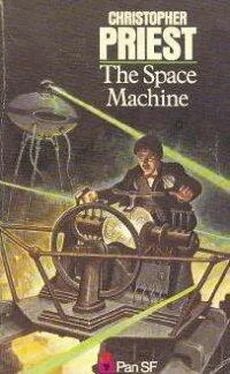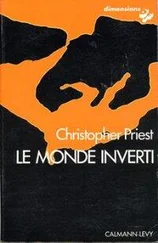Inside the area itself there were more monsters in evidence than I had ever seen anywhere on Mars, but once past the guard-post we were ignored. Most of the odious creatures had legged vehicles in which to move about, but I saw several who were dragging themselves slowly along the ground. This was the first time I had seen this; until now I had assumed that without their mechanical aids the monsters were helpless. Indeed, in face-to-face combat with a human a monster would be totally vulnerable, for the motion was slow and painful, four of the tentacles being used as clumsy, crab-like legs.
The presence of the monsters was not, however, the most intimidating aspect of this area.
Having noticed the cannon-site buildings while walking towards them from the city, I had registered that they were of great size, but now we were among them I realized just how enormous were the engines of science on this world. Walking between the buildings, it was as if we were ants in a city street.
My guides attempted to explain the purpose of each building as we passed it. Edwina’s vocabulary was limited, and I obtained only the vaguest idea of the overall plan. As far as I could understand, the various components of the battle-machines were manufactured in the outlying factories, then brought to this place where they were assembled and primed. In one building—which must have been at least three hundred feet high—I could see through immense open doors that several of the tripodal battle-machines were in the process of being built: the one furthest from us was no more than a skeletal framework suspended from pulleys, while beneath it one of the three legs was being attached, but the battle-machine nearest us seemed to be complete, for its platform was being rotated while around it many supplementary instruments scanned and tested.
Both men and monsters worked in these mighty sheds, and to my eyes it seemed that the co-existence was unforced. There were no obvious signs of the slave-rule, and it occurred to me that perhaps not every human on Mars would welcome the revolution.
After we had passed some twenty or so of these sheds, we came to a vast stretch of open land, and I stopped dead in my tracks, speechless at what I saw.
Here were the fruits of such prodigious industry. Lined up, in one rank after another, were the projectiles. Each one was identical to the next, as if each had been turned on the same lathe by the same craftsman. Each one was machined and polished to a gleaming, golden shine; there were no extrusions to mar the cleanness of the line. Each one was nearly three hundred feet in length, sharply pointed at the nose, curving up so that the craft had a cylindrical body for most of its length, and its rear was circular, revealing the huge diameter. I had stood amazed at the size of the craft fired by the monsters of Desolation City,but they were mere playthings compared to these. I could hardly credit what I saw, but as I walked past the nearest of the projectiles I realized that it must have an overall diameter of around ninety feet!
My guides walked on unconcerned, and after a moment I followed them, craning my neck and marvelling.
I tried to estimate how many projectiles there were, but the area on which they were laid was so vast that I was not even sure I could see all the craft. Perhaps each rank had upwards of a hundred such waiting projectiles, and I passed through eight ranks of them.
Then, as we emerged from between the projectiles in the front rank, I was confronted with the most astonishing sight of all.
Here it was that the ascending slope of the volcano became pronounced, rising before us. Here it was that the monster-creatures of this hateful city had laid their snow-cannons.
There were five in all. Four of them were of the same order as the one at Desolation City, but there was no complication here with pivotal buildings and a lake to absorb the heat, for the barrels of the cannon were laid along the slope of the mountain itself! Nor was there any need for the elaborate process of inserting the projectile through the muzzle, for by a cunning arrangement of railway lines, and a stout entrance at the breech of the barrel, the projectiles could be loaded here.
But my attention was not drawn towards these pieces of ordnance, for, mighty as they were, their presence was over shadowed by the fifth snow-cannon.
Whereas the lesser snow-cannons had barrels a mile or so long, with bores of about twenty feet, this central cannon had a barrel with an external diameter well in excess of one hundred feet. As for its length … well, it extended further than the eye could see, running straight and true up the side of the mountain, sometimes resting on the soil, sometimes carried by huge viaducts where the slope was less pronounced, sometimes running through canyons blasted from the rock itself. At its base, the very breech was like a metal mountain of its own: a great, bulbous piece of black armour, thick enough and mighty enough to support the ferocious blast of the vaporizing ice which powered the projectiles. It loomed over everything, a stark reminder of the terrible skills and sciences these accursed monster-creatures commanded.
It was with this cannon, and with these hundreds of gleaming projectiles, that the monster-creatures plotted their invasion of Earth!
A projectile had been placed already in the breech, and my guides led me up a metal companionway that attached to the bulk of the cannon like a flying buttress against the wall of a cathedral. From its dizzying height I looked down across the massed machines of the monsters, and beyond them, across the dividing strip of land to the near-by city.
The companionway ended at one of the access-points to the barrel itself, and we entered through a narrow tunnel. At once the temperature fell sharply. Interpreting for one of the men, Edwina explained that the barrel was already lined with ice, and that its entire length could be relined and frozen in just over half a day.
The tunnel led directly to a hatch into the craft itself. I suppose I had been expecting a larger version of the projectile in which I had already flown, but this was so only in its overall design.
We stepped out of the hatch into the forward control-area, and from here explored the entire craft.
As with the smaller projectiles, this one was divided into three main areas: the control section, a hold in which the slaves would be carried and the main hold in which the monsters and their terrible battle-machines were to ride. These last two compartments were linked by one of the blood-letting devices. That at least was no different, but one of the men explained that during the flight the monsters would be sedated with a sleeping-draught, and that their food requirements would be minimal.
I had no desire to dwell on this aspect of the monsters’ arrangements, and so we passed on into the main hold itself.
Here I saw the full scale of the monsters’ arsenal. Five of the tripodal battle-machines were stored here, their legs detached and neatly folded, the platforms collapsed to occupy as little space as possible. Also aboard were several of the small, legged vehicles, a score or more of the heat-cannons, and innumerable quantities of different substances, packaged away in dozens of huge containers. Neither I nor my guides could hazard a guess as to what these might be.
At various parts of the hold hung the tubes of transparent material which absorbed the shocks of launch and landing.
We did not stay long in this hold, but I saw enough to realize that what was here was in itself reason enough to fly to Earth. What a prize this would be for our scientists!
The control-area, in the prow of the ship, was a huge room with the overall shape of the pointed nose of the craft. The projectile had been set in the barrel in such a way that the controls were on what was presently the floor, but it was explained to me that in flight the craft would be rotated so as to produce weight. (This was a concept lost on me, and I decided that Edwina’s translation was inadequate.) After the cramped quarters of the other projectile the control-area was palatial indeed, and the builders had gone to some pains to make the drivers comfortable. There was much dried food available, a tiny commode, and in one part of the wall was a shower-system, rather like the one we had used at the slave-camp. The siting of this, and the hammocks on which we would sleep, was rather puzzling, for they had been hung from the ceiling, some eighty feet above our heads.
Читать дальше











